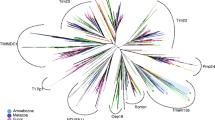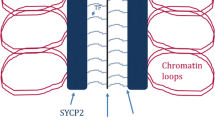Abstract
A search for proteins similar to known synaptonemal complex (SC) proteins of seven higher eukaryote species, from budding yeast to mice (which are widely used as models for the study of meiosis), was conducted in the proteomes of algae, mosses, lower fungi, and Protozoa, using bioinformatics methods. It was established that proteins containing the HORMA domain have the largest similarity with the SC proteins of model organisms in proteomes of green and brown algae, mosses, and a number of lower fungi, as well as Euglenozoa, Sporozoa, and some other unicellular eukaryotes. They are close to the proteins of the lateral elements of the SC of higher eukaryotes that also carry the HORMA domain. This domain recognizes the state of chromatin and recruits other proteins for SC construction.
Similar content being viewed by others
References
Anuradha, S. and Muniyappa, K., Molecular aspects of meiotic chromosome synapsis and recombination, Progr. Nucl. Acid Res. Mol. Biol., 2005, vol. 79, pp. 49–132.
Bogdanov, Yu.F., Variation and evolution of meiosis, Russ. J. Genet., 2003, vol. 39, no. 4, pp. 363–381.
Bogdanov, Yu.F., Similarity of domain organization of proteins in phylogenetically distant organisms as a basis of meiosis conservatism, Russ. J. Dev. Biol., 2004, vol. 35, no. 6, pp. 337–344.
Bogdanov, Y.F., Grishaeva, T.M., and Dadashev, S.Y., Similarity of the domain structure of proteins as a basis for the conservation of meiosis, Int. Rev. Cytol., 2007, vol. 257, pp. 83–142.
Bogdanov, Yu.F., Grishaeva, T.M., Karpova, O.I., and Penkina, M.V., The role of specific proteins in the evolution of meiosis, in Sovremennye problemy biologicheskoi evolyutsii: Tr. konf. K 100-letiyu Gos. Darvinovskogo muzeya. 17–20 sentyabrya 2007, Moskva (Modern Problems of Biological Evolution, Proc. Conf. Dedicated to the 100th Anniversary of the State Darwin Museum, September 17–20, 2007, Moscow), Moscow: Izd. GDM, 2008, pp. 7–30.
Bogdanov, Yu.F., The evolution of meiosis of unicellular and multicellular eukaryotes. Aromorphosis at the cellular level, Zh. Obshch. Biol., 2008, vol. 69, no. 2, pp. 4102–117.
Egel, R., On the origin of meiosis in eukaryotic evolution: coevolution of meiosis and mitosis from feeble beginnings, in Genome Dynamics and Stability, Vol. 3: Recombination and Meiosis, Egel, R. and Lankenau, D.-H., Eds., Berlin: Springer-Verlag, 2007, pp. 249–288.
Grishaeva, T.M. and Zakharov, I.A., Comparison of eukaryotic nuclear proteins with prokaryotic proteins: implications for eukaryogenesis, Curr. Topics Genet., 2012, vol. 5, pp. 31–36.
Heyting, C., Synaptonemal complex: structure and function, Curr. Opin. Cell Biol., 1996, vol. 8, pp. 389–396.
Hirano, T., SMC proteins and chromosome mechanics: from bacteria to humans, Phil. Trans. R. Soc. B, 2005, vol. 360, pp. 507–514.
King, N., Westbrook, M.J., Young, S.L., et al., The genome of the choanoflagellate Monosiga brevicollis and the origin of metazoans, Nature, 2008, vol. 451, pp. 783–788.
Li, W. and Zheng, G.-Ch., A resurgent phoenix-a hypothesis for the origin of meiosis, Life, 2002, vol. 54, pp. 9–12.
Loidl, J., S. pombe linear elements: the modest cousins of synaptonemal complexes, Chromosoma, 2006, vol. 115, pp. 260–271.
Maguire, M.P., Evolution of meiosis, J. Theor. Biol., 1992, vol. 154, pp. 43–55.
Meuwissen, R.L.J., Offenberg, H.H., Dietrich, A.J.J., et al., A coiled-coil related protein specific for the synapsed regions of meiotic prophase chromosomes, EMBO J., 1992, vol. 11, pp. 5091–5100.
Page, S.L. and Hawley, R.S., The genetics and molecular biology of the synaptonemal complex, Annu. Rev. Cell Dev. Biol., 2004, vol. 20, pp. 525–558.
Penkina, M.V., Karpova, O.I., and Bogdanov, Yu.F., Synaptonemal complex proteins: specific proteins of meiotic chromosomes, Mol. Biol. (Moscow), 2002, vol. 36, no. 3, pp. 304–313.
Revenkova, E. and Jessberger, R., Shaping meiotic prophase chromosomes: cohesins and synaptonemal complex proteins, Chromosoma, 2006, vol. 115, pp. 235–240.
Zakharov, I.A., Dadashev, S.Ya., and Grishaeva, T.M., Orthologs of meiotic proteins in prokaryotic proteomes, Dokl. Akad. Nauk, 2010, vol. 435, no. 5, pp. 327–329.
Author information
Authors and Affiliations
Corresponding author
Additional information
Original Russian Text © T.M. Grishaeva, Yu.F. Bogdanov, 2013, published in Vavilovskii Zhurnal Genetiki i Selektsii, 2013, Vol. 17, No. 2, pp. 335–342.
Rights and permissions
About this article
Cite this article
Grishaeva, T.M., Bogdanov, Y.F. On the origin of synaptonemal complex proteins. Search for related proteins in proteomes of algae, lower fungi, mosses, and protozoa. Russ J Genet Appl Res 3, 481–486 (2013). https://doi.org/10.1134/S2079059713060038
Received:
Accepted:
Published:
Issue Date:
DOI: https://doi.org/10.1134/S2079059713060038




